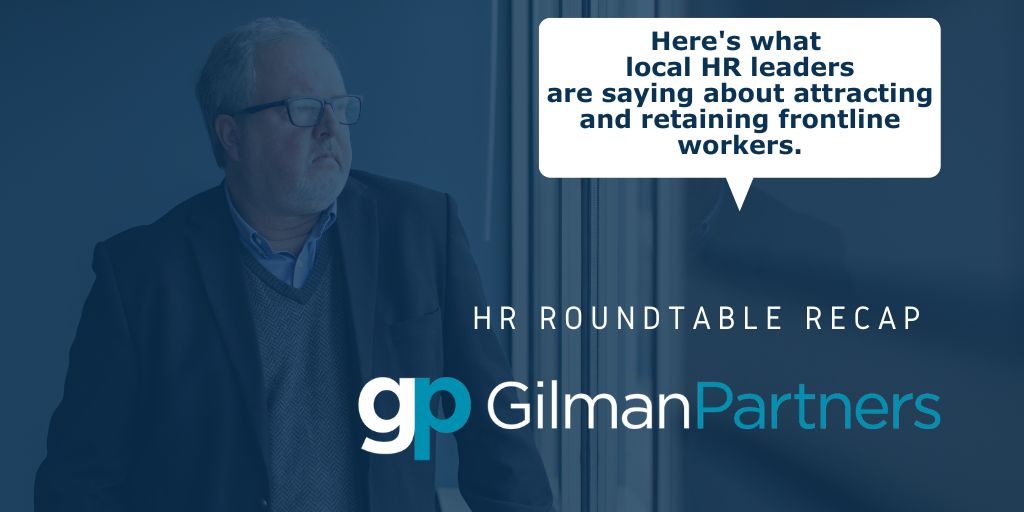This morning, more than 30 HR leaders from across the Cincinnati and Northern Kentucky region met virtually to discuss the challenges they’re facing with recruiting hourly workers as well as the successful, innovative ideas that have worked for them. Here are some of the key themes that emerged from today’s roundtable conversation:
Attracting frontline talent
- One HR leader referred to his organization’s previous job applicants as his “talent community.” He has reached out to many of them to learn what new skills and experiences they have acquired and whether they would now be a good fit for his company. Of the 160 previous applicants he has contacted so far, 14 have entered his candidate pipeline.
-
Some organizations are finding success hiring second-chance workers, partnering with local high schools, colleges and trade schools, and tapping into social service/workforce development organizations to expand their talent pool.
- A few of today’s roundtable leaders have utilized referral bonuses to recruit new talent. One said his organization offers a $500 referral bonus for employees who refer a new hire as long as the new team members stays beyond 60 days. Another leader in our roundtable is offering $1,000 after 30 days. An additional priority one leader mentioned was working to strengthen relationships with employee alumni to broaden their reach by connecting with previous employees.
- Other organizations are building pipelines of new hires by engaging with high school seniors in the six months prior to graduation, connecting with batches of new hires as they are about to enter the workforce.
- Many leaders shared the need to be more flexible about candidate requirements on their job postings, assessing which skills are crucial and which can be taught as well as what educational requirements are necessary. Requiring even a high school degree was deterring many capable frontline employees from applying, so one leader shared his organization implemented a program that helps new hires earn their GED as a benefit of employment.
- Incentives for new hires have been a common trend so far in 2021. Multiple organizations have implemented some form of a sign-on bonus or increased pay to attract new hires. For other applicants, being able to work from home for even part of the week would make a new position more attractive.
- Another leader shortened his organization’s online job application that was too long and deterred candidates from pursuing positions in his organization.
- A few HR leaders noted they have become a bit less rigid with their drug screening processes.
- In hopes of attracting new high school graduates, one organization offered work-hour flexibility that allowed for a later shift starting time, knowing most new grads would not apply for a job that started at 6 a.m.
Speeding up the hiring process
- When organizations are slow to hire, job candidates in the current market move on to other opportunities. One leader shared, “The hiring cycle used to be 35-36 days, but today it needs to be half of that.” He cut his organization’s hiring time in half by streamlining the recruiting process.
- An organization that meets a lot of candidates at job fairs recognized that asking candidates to go home and apply online lengthened the hiring process. Instead, they created a way for candidates to apply on the spot at the job fair to accelerate the process.
- Several leaders in today’s roundtable mentioned the time drug screens and background checks add to the hiring processes. One leader hosted a job fair with on-site, rapid testing that allowed candidates to move through the process quickly.
- One organization, recognizing that candidates found other job opportunities while waiting two or three days for drug screen and background checks to come back, pays candidates for the time they are waiting for results to return. Then they offer a signing bonus and a stay bonus at 60 days.
Retention
- While attracting and hiring new talent is a priority in 2021, many of today’s roundtable leaders stressed the need to focus on retention. As one leader said, “The workforce we have is the workforce we want to invest in.”
- One leader implemented “stay interviews” with the top talent her organization wanted to retain most. She shared that between increasing pay to be more competitive and conducting these stay interviews, they have seen turnover decrease by half.
- Just like attracting talent, retaining talent now requires increased flexibility. We heard many innovative solutions around flexibility in today’s roundtable.
- Instead of requiring a set worktime, one organization is now allowing those in their plants to work any 9 of the 24 hours in a day. This required extra manual effort for payroll tracking, but by being more accommodating they have been able to attract and retain more talent.
- Another organization has tapped into the “cottage industry,” by allowing some team members to pick up raw materials, do light assembly work at home, and return with finished products.
- Another avenue organizations are using to retain workers is focusing on the organization’s mission and promoting the impact it has on the community. Employees are increasingly seeking purpose in the work they do and organizations that make a difference and communicate their impact to their team see less turnover.
There is no secret sauce or one tactic that works for all organizations. The goal is to attack the challenge from multiple angles. One leader said it best, “If we’re going to try what we’ve always done, we will get what we’ve always got. It Is about breaking down the hiring and recruiting process and analyzing what we can improve within each step.”




